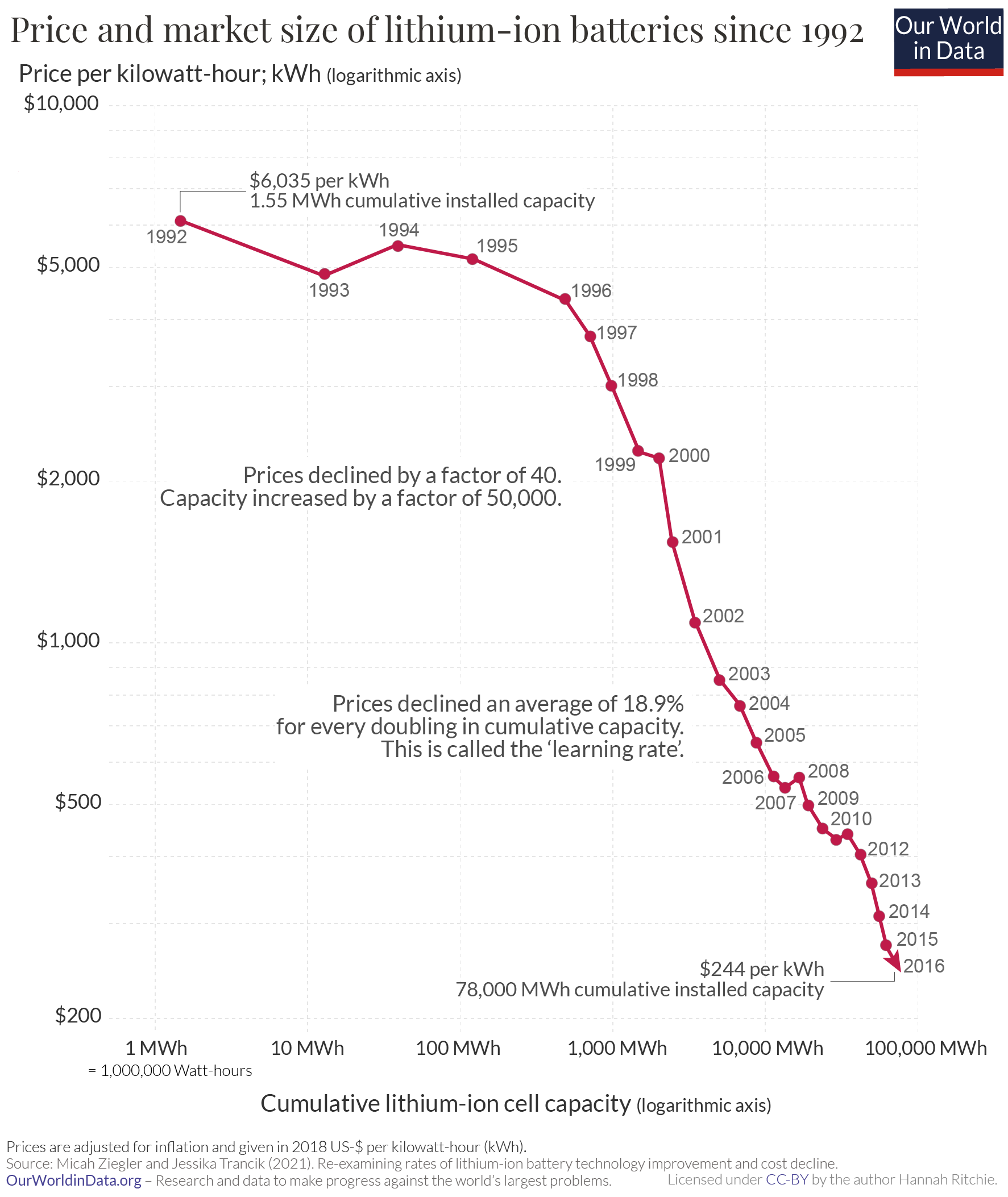Summary
To reduce global greenhouse gas emissions we need to shift towards a low-carbon energy system. Large reductions in the cost of renewable technologies such as solar and wind have made them cost-competitive with fossil fuels. But to balance these intermittent sources, and electrify our transport systems we also need low-cost energy storage. Lithium-ion batteries are the most commonly used.
In this article I show that lithium-ion battery cells have also seen an impressive price reduction. Since 1991, prices have fallen by around 97%. Prices fall by an average of 19% for every doubling of capacity. Even more promising is that this rate of reduction does not yet appear to be slowing down.
To reduce emissions the world needs to rapidly transition towards a low-carbon energy system. Around three-quarters of global greenhouse gas emissions come from energy and industry.
One of the barriers to this energy transition has been the relative cost of different energy sources. Fossil fuels were cheaper than renewables and therefore became the dominating sources of energy.
Thankfully this is changing quickly. As my colleague Max Roser showed in this article, the cost of renewable technologies has plummeted. They’re now cost-competitive or cheaper than new fossil fuels. In 2009, it was more than three times as expensive as coal. Now the script has flipped and a new solar plant is almost three times cheaper than a new coal one. The price of electricity from solar declined by 89% between 2009 and 2019.
But the cost of electricity technologies themselves is only part of what matters for this transition. One of the challenges that renewables face is that they produce energy intermittently. The sun doesn’t always shine and the wind doesn’t always blow and so we don’t get a steady flow of generation throughout the day.1 An obvious solution is to store excess energy then release it later. But to do so, we need lots of energy storage and this adds large costs to our energy system.2
The promising news is that these technologies have seen similarly impressive price declines as solar panels have.
The price of lithium-ion batteries has declined by 97% since 1991
There are several ways to store excess energy. Most of us think of batteries. Here we’re going to look at lithium-ion batteries: the most common type. Lithium-ion batteries are used in everything, ranging from your mobile phone and laptop to electric vehicles and grid storage.3
The price of lithium-ion battery cells declined by 97% in the last three decades. A battery with a capacity of one kilowatt-hour that cost $7500 in 1991, was just $181 in 2018. That’s 41 times less. What’s promising is that prices are still falling steeply: the cost halved between 2014 and 2018. A halving in only four years.
We see this decline in the chart, which shows the average price trend of lithium-ion cells from 1991 through to 2018.4 This is shown on a logarithmic axis, and measured in 2018 US dollars per kilowatt-hour.5 This data comes from the work of Micah Ziegler and Jessika Trancik, who constructed a global database tracking lithium-ion cell prices, installed capacity and other metrics such as energy density over time.6 This database combines data from 90 series that describe how lithium-ion technologies have changed from 1990 onwards. The full article includes many more results and the authors’ discussion of their relevance, as well as the methodology behind this work. Additionally, you can also access the associated data series.
Let’s put this price decline in perspective:
- The popular Nissan Leaf electric car – which is also one of the most affordable models – has a 40 kWh battery. At our 2018 price, the battery costs around $7,300. Imagine trying to buy the same model in 1991: the battery alone would cost $300,000.
- Or take the Tesla Model S 75D which has a 75 kWh battery. In 2018 the battery costs around $13,600; in 1991 it would have been $564,000. More than half a million dollars for a car battery.
This shows how important these price reductions are for decarbonizing not only our electricity grids but our transport systems too.
[If you’re interested in the prices of other vehicle models, the Carbon Counter tool, lets you see the cost and greenhouse gas breakdowns for others].
Smaller and lighter: deployment and technological improvements are making batteries cheaper and cheaper
We often look at these price reductions relative to time. But, of course, it’s not time itself that drives these reductions. It’s the innovations in the production of these batteries that make it possible to produce them at lower and lower costs. As production increases there are more opportunities and incentives to achieve such innovations: that’s why prices often fall when technologies begin to scale [Max’s post looks at this mechanism – called Wright’s Law – in detail].
In the chart we see the relationship between prices and cumulative installed capacity of batteries. Both are shown on logarithmic axes.
In 1991 the market size of lithium-ion cells was tiny: there was just 0.13 megawatts (MWh) installed. That’s just 130 kWh – less than two 75 kWh battery packs that you’d find in a Tesla car. Since then deployed capacity has increased rapidly. By 2016, this had grown to 78,000 MWh. That’s six orders of magnitude higher.
The relationship between price and cumulative installed capacity is called the ‘learning curve’. This is a concept that is often used to understand cost improvements in scaling technologies. The learning rate tells us, on average, how much the price of something falls for every doubling of cumulative capacity. We find that for lithium-ion cells, this learning rate was 20.1%. This means prices fell an average of 18.9% every time the installed capacity doubled. As it happens, this is similar to the learning rate of solar modules; with every doubling of installed solar capacity, the price of solar modules dropped by an average of 20.2%.
The improvements we’ve seen in battery technologies are not limited to lower costs. As Ziegler and Trancik show, the energy density of cells has also been increasing. Energy density measures the amount of electrical energy you can store in a liter (or unit) of battery. In 1991 you could only get 200 watt-hours (Wh) of capacity per liter of battery. You can now get over 700 Wh. That’s a 3.4-fold increase.
What this means is that batteries have been getting smaller and lighter for any given electrical capacity. You might have noticed this yourself as your mobile phones were getting lighter and slimmer. This is a crucial technological improvement as one of the major drawbacks of some battery technologies is that they are heavy and this limits their use in a number of technologies that are still fossil fuel powered. Imagine trying to fly an electric plane full of heavy batteries. In fact, the size and weight of batteries that you’d need to power large aircraft is one the biggest barriers to a transition to electrified aviation.7 The same is true for shipping or trucks: bigger and heavier batteries just make everything more costly in energy terms.8 You need lots of large batteries, which take up space and add weight to carry around.
Our batteries are now only a fraction of the cost and are smaller and lighter. These technological improvements are just as essential to making low-carbon electricity the default affordable option as reductions in the cost of solar panels or wind turbines. But there is still a lot to do if we want to fly in electric airliners, or have our goods transported across the oceans in electric ships any time soon.





